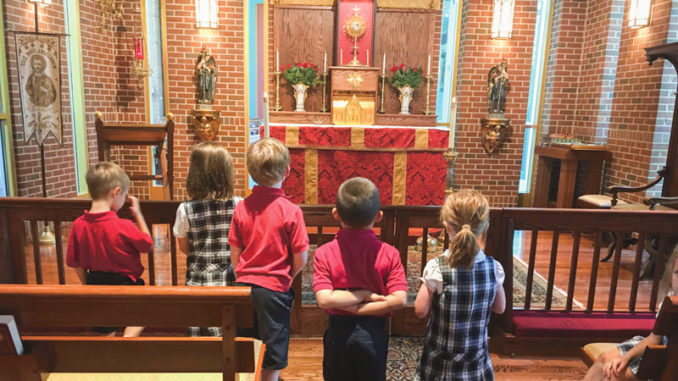
SOUTH CAROLINA—Kim Capelle entered the adoration chapel at Prince of Peace Church in Taylors, took out her rosary, and began an hour of prayer that connected her with hundreds of others, young and old, in churches across the state and country.
Capelle and the others were part of the first diocesan Rosary Congress, which started at 8 a.m. Oct. 7 and ended at 8 a.m. Oct. 13.
Each of the seven days was hosted by one parish from each deanery, with each location offering 24-hour adoration of the Blessed Sacrament, with the rosary recited at the beginning of each hour.
Kathy Schmugge, director of the Office of Family Life, worked to make the event a reality after Bishop Robert E. Guglielmone gave permission for a congress to be held in the diocese.
The Rosary Congress movement started in the United States in the late ’80s and is based on the first event held in Poland in May 1979. Then, people around the nation prayed the rosary around the clock for the government to allow Pope John Paul II to make a pilgrimage back to his homeland.
The Diocese of Charleston is one of 20 dioceses and archdioceses in the United States to host a Congress in 2019.

The week of prayer started at Immaculate Conception Church in Goose Creek, and continued at St. Michael Church in Murrells Inlet, St. Anne in Rock Hill, Prince of Peace in Taylors, St. Mary Help of Christian’s St. Clare Chapel in Aiken, Our Lady of the Lake Church in Chapin, and St. Gregory the Great in Bluffton.
Participants were asked to pray especially for eight intentions: to give glory to God, console the heart of Jesus, reparation of our sins and the sins of the nation, the healing of victims of abuse, the healing of the Church, an end to abortion or any attack on human life, for peace in the world, and for the sanctification of families.
The Shrine of Our Lady of South Carolina – Our Lady of Joyful Hope in Kingstree also hosted daily adoration, Mass and recitation of the rosary, said Father Stanley Smolenski, shrine director. He offered homilies each day that focused on a different aspect of the Blessed Mother, and visitors to the shrine prayed for her intercession.
Students from St. Anne School in Rock Hill joined in by praying a rosary during their children’s Mass, and students from Prince of Peace School in Taylors presented a “Living Rosary.”
In Columbia, adoration and the rosary took place at Cardinal Newman School, and then moved to the adoration chapel at Our Lady of the Lake. Many who participated in the congress in the Midlands also attended a conference for young families and a pro-life event at Cardinal Newman on the same day.
At St. Gregory the Great, in addition to praying a rosary for families, people also walked around the grounds in a Marian procession. Participants carried a new statue of Our Lady of Guadalupe, which will be displayed at the church, said Jennifer Bermejo, Hispanic ministry assistant. Afterward, the group enjoyed a food festival in the parish life center.
Capelle said the congress was a moving experience for her because she felt especially close to God during her hour in the adoration chapel, and has seen real changes as a result.
“I’ve seen some real graces happening as a result of the congress, for me and for others,” she said. “I have seen friends who took part that have greater peace of heart and some that have received help with struggles they are experiencing. It was a great idea for the diocese to have the event because with all the things we are fighting against in today’s world, we really need to turn even more to the Blessed Mother.”
To learn more about the Rosary Congress movement, visit www.rosarycongressusa.org.
